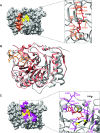First insights into the structural features of Ebola virus methyltransferase activities
- PMID: 33503246
- PMCID: PMC7897494
- DOI: 10.1093/nar/gkaa1276
First insights into the structural features of Ebola virus methyltransferase activities
Abstract
The Ebola virus is a deadly human pathogen responsible for several outbreaks in Africa. Its genome encodes the 'large' L protein, an essential enzyme that has polymerase, capping and methyltransferase activities. The methyltransferase activity leads to RNA co-transcriptional modifications at the N7 position of the cap structure and at the 2'-O position of the first transcribed nucleotide. Unlike other Mononegavirales viruses, the Ebola virus methyltransferase also catalyses 2'-O-methylation of adenosines located within the RNA sequences. Herein, we report the crystal structure at 1.8 Å resolution of the Ebola virus methyltransferase domain bound to a fragment of a camelid single-chain antibody. We identified structural determinants and key amino acids specifically involved in the internal adenosine-2'-O-methylation from cap-related methylations. These results provide the first high resolution structure of an ebolavirus L protein domain, and the framework to investigate the effects of epitranscriptomic modifications and to design possible antiviral drugs against the Filoviridae family.
© The Author(s) 2021. Published by Oxford University Press on behalf of Nucleic Acids Research.
Figures





Similar articles
-
The C-Terminal Domain of the Sudan Ebolavirus L Protein Is Essential for RNA Binding and Methylation.J Virol. 2020 Jun 1;94(12):e00520-20. doi: 10.1128/JVI.00520-20. Print 2020 Jun 1. J Virol. 2020. PMID: 32269120 Free PMC article.
-
The methyltransferase domain of the Sudan ebolavirus L protein specifically targets internal adenosines of RNA substrates, in addition to the cap structure.Nucleic Acids Res. 2018 Sep 6;46(15):7902-7912. doi: 10.1093/nar/gky637. Nucleic Acids Res. 2018. PMID: 30192980 Free PMC article.
-
Zika Virus Methyltransferase: Structure and Functions for Drug Design Perspectives.J Virol. 2017 Feb 14;91(5):e02202-16. doi: 10.1128/JVI.02202-16. Print 2017 Mar 1. J Virol. 2017. PMID: 28031359 Free PMC article.
-
Structures of the Mononegavirales Polymerases.J Virol. 2020 Oct 27;94(22):e00175-20. doi: 10.1128/JVI.00175-20. Print 2020 Oct 27. J Virol. 2020. PMID: 32847861 Free PMC article. Review.
-
Filovirus proteins for antiviral drug discovery: Structure/function bases of the replication cycle.Antiviral Res. 2017 May;141:48-61. doi: 10.1016/j.antiviral.2017.02.004. Epub 2017 Feb 10. Antiviral Res. 2017. PMID: 28192094 Review.
Cited by
-
Internal RNA 2'O-methylation in the HIV-1 genome counteracts ISG20 nuclease-mediated antiviral effect.Nucleic Acids Res. 2023 Apr 11;51(6):2501-2515. doi: 10.1093/nar/gkac996. Nucleic Acids Res. 2023. PMID: 36354007 Free PMC article.
-
SARS-CoV-2 nsp16 is regulated by host E3 ubiquitin ligases, UBR5 and MARCHF7.Elife. 2025 May 13;13:RP102277. doi: 10.7554/eLife.102277. Elife. 2025. PMID: 40358464 Free PMC article.
-
NanoNet: Rapid and accurate end-to-end nanobody modeling by deep learning.Front Immunol. 2022 Aug 12;13:958584. doi: 10.3389/fimmu.2022.958584. eCollection 2022. Front Immunol. 2022. PMID: 36032123 Free PMC article.
-
In silico drug repurposing of potential antiviral inhibitors targeting methyltransferase (2'-O-MTase) domain of Marburg virus.In Silico Pharmacol. 2025 Apr 24;13(2):70. doi: 10.1007/s40203-025-00355-z. eCollection 2025. In Silico Pharmacol. 2025. PMID: 40291443
-
Biochemistry of the Respiratory Syncytial Virus L Protein Embedding RNA Polymerase and Capping Activities.Viruses. 2023 Jan 25;15(2):341. doi: 10.3390/v15020341. Viruses. 2023. PMID: 36851554 Free PMC article. Review.
References
-
- Lawrence P., Danet N., Reynard O., Volchkova V., Volchkov V.. Human transmission of Ebola virus. Curr. Opin. Virol. 2017; 22:51–58. - PubMed
-
- Ollmann Saphire E. A Vaccine against Ebola Virus. Cell. 2020; 181:6. - PubMed
-
- Elliott L.H., Sanchez A., Holloway B.P., Kiley M.P., McCormick J.B.. Ebola protein analyses for the determination of genetic organization. Arch. Virol. 1993; 133:423–436. - PubMed
-
- Sanchez A., Kiley M.P., Holloway B.P., Auperin D.D.. Sequence analysis of the Ebola virus genome: organization, genetic elements, and comparison with the genome of Marburg virus. Virus Res. 1993; 29:215–240. - PubMed
-
- Ogino T., Banerjee A.K.. Unconventional mechanism of mRNA capping by the RNA-dependent RNA polymerase of vesicular stomatitis virus. Mol. Cell. 2007; 25:85–97. - PubMed
Publication types
MeSH terms
Substances
LinkOut - more resources
Full Text Sources
Other Literature Sources
Medical
Miscellaneous

